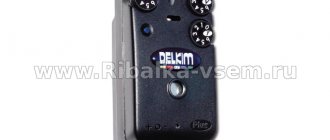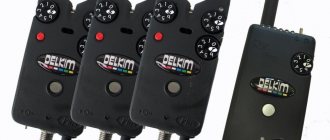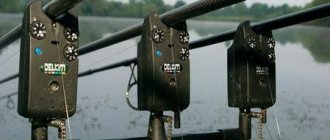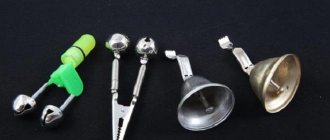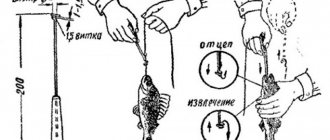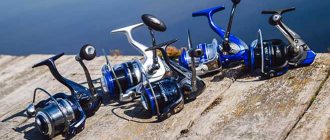The bite alarm for the feeder allows you to hook the fish in time, which practically guarantees successful fishing. Alarms come in a wide variety. They can report a bite visually or by sound.
In particular, you can make a bite alarm for the feeder with your own hands, using available materials.
Visual alarms
Such products are designed for visual control of bites. They are divided into several types:
- plastic thin upper tips for the rod;
- fireflies (glow at night);
- swingers;
- side nods.
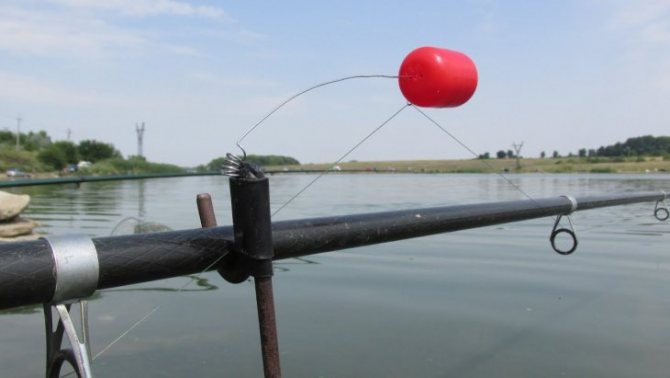
Such alarms have the following advantages:
- suitable for use day and night;
- can be used in conjunction with almost any equipment;
- ease of manufacture
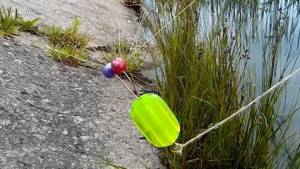
The price of bite alarms for feeders can vary significantly depending on the type of device. If you make it yourself, it can be completely free if you use available materials.
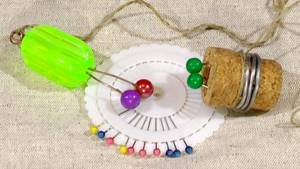
Types of existing alarms
The most famous and most used bite alarm is a regular float , used in various equipment when fishing with a float rod. But in recent years, bite alarms for feeders have become very popular. This is not surprising, given how popular this method of catching bottom fish is becoming.
There are several types of devices that help the fisherman not to miss a bite. This:
- visual alarms;
- sound alarms;
- hybrid;
- various electronic devices that can be classified as both visual and audio.
The visual category includes: various nods , beacons , fireflies , pendulums , glowing tubes , etc. These are simple devices, the main working parts of which are made as bright as possible to attract the attention of the fisherman.
Sound alarms include bells , bells , metal tubes , etc. Sound devices have the advantage of not having to be constantly monitored by the fisherman. A sound will notify him of a bite.
Electronic devices mainly include industrial products that can be purchased at retail outlets. The main disadvantage of electronic assistants is their high price and insufficient protection from external factors (water, sun, dust).
The feeder alarm can be attached to different parts of the equipment, for example:
- At the very tip of the feeder rod. Despite the fact that the tips of such rods themselves are considered quite sensitive and informative, the alarms installed there are never superfluous; with their help, hook detection becomes much more timely. Their main drawback is that before hooking or immediately after hooking, when landing fish, this device must be removed from the tip of the form.
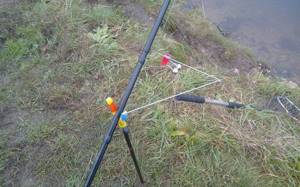
- Directly at the butt of the rod, usually between the first and second guide rings. Most often, this is how the side bite alarm for the feeder is attached. The main element of such devices is various elastic plates or springs.
- Another option is to attach the device to a rod rack. Most often, nods of various designs are attached in this way, which are complemented by bells or bells .
Do-it-yourself bite alarms for feeders, as a rule, take into account all the features of the gear for which they are adapted; moreover, they are much simpler and more reliable, and therefore can be much more effective than industrial models.
Fireflies
Firefly is an electronic feeder bite alarm designed for night fishing.
The design provides for a sealed capsule containing an LED and batteries. The alarm is attached to the fishing rod or bell.
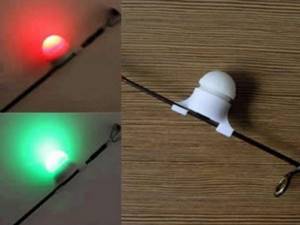
There are also fireflies based on the use of special liquids. This is a small plastic capsule containing 2 liquids.
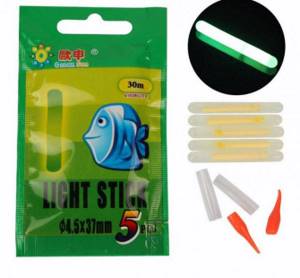
When a bite occurs, the liquids are mixed, as a result of which a chemical reaction begins, the device glows, indicating a bite.

Sound bite detectors for feeder
Mechanical sound alarms are not very widely represented, but all fishermen are well aware of the “bells” on plastic clothespins, which are attached to the top of the feeder and emit a melodic sound when bitten.
Advantages:
- compact;
- are not “afraid” of water;
- securely attached to the rod tip;
- are inexpensive.
Flaws:
- after hooking, it is necessary to remove the device from the rod so as not to irritate others with sharp sounds;
- “bells” are characterized by low sensitivity when biting on the shore;
- in strong winds there are many false alarms;
- Moisture causes the metal to rust and the alarm device fails.
There are situations when, after a strong hook, the bell flies off the rod and you have to look for it for a long time on the shore, or even in the water, which causes a lot of inconvenience to the fisherman.
Homemade firefly for feeder
You can make a homemade bite alarm for the feeder that will glow at night. To do this you need:
- A plastic tube 5-7 cm long (can be used for polyurethane foam).
- White LED. It needs to be inserted into the tube and secured with glue.
- 3V battery. Place it in the heat shrink tube to ensure a seal.

Connect the LED to the battery; you can use hot glue for insulation. You can attach the alarm to the tip of the rod using adhesive tape.
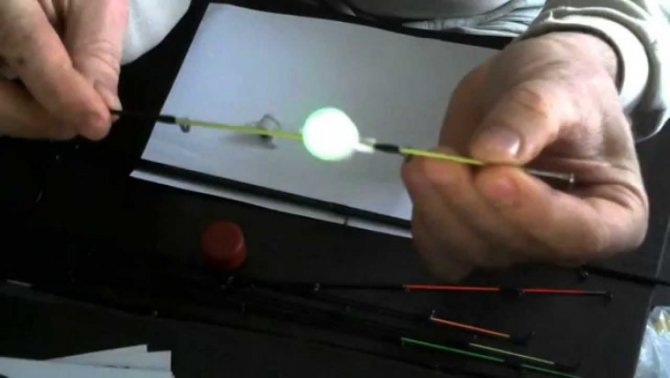
There are ready-made battery-powered fireflies on sale that begin to glow when the tension of the fishing line changes. They are more effective because they signal directly when a bite occurs.
Model options
Nod
Perhaps this DIY feeder bite alarm can be considered one of the simplest, but also one of the most sensitive . To make it you will need:
- A 10-15 centimeter piece of any springy material with a small cross-section. It can be an elastic wire, a steel plate or a spring.
- A polymer or durable rubber tube 3 to 5 cm long. It is useful for attaching the nod to the tip of the form.
- Colored varnish.
At one end of the elastic element (nod body), using pliers, you need to make a small loop (ring) for threading the main fishing line into it. After this, using a polymer or rubber tube, the nod is attached to the tip of the fishing rod. This fastening should be tight, but at the same time it should not interfere with changing the length of the working part of the nod. This allows you to adjust its sensitivity. To make the nod more visible, you need to cover its body with a bright, waterproof varnish.
After securing the nod, we thread the fishing line through its ring, equip it and start fishing. Since the material from which it is made is quite elastic, there is no need to disconnect it from the form when hooking and subsequent fishing.
Such a homemade bite alarm, after equipping a fishing rod with it, can serve for quite a long time without repairs or additional adjustments .
Firefly
Firefly is a feeder alarm designed to detect bites at night . As a rule, this is the name given to polymer tubes, which, after breaking them, preferably in several places, due to a chemical reaction, begin to glow in the dark. They usually complement visual homemade bite alarms for the feeder. It is also possible to attach such a tube, 3 to 6 centimeters long, to the flexible tip of a feeder rod. This is done using colorless tape or a polyethylene tube of suitable diameter.
In addition to such luminous tubes, you can use various phosphorescent (glow in the dark) materials and paints, as well as miniature LEDs .
The principle of their operation is the same - fastening to the working elements of mechanical signaling devices (nods, pendulums, etc.).
In this simple way, you can make a light bite indicator on the feeder, which will be noticeable at any time of the night at a distance of up to 10 - 15 meters .
Side warning light
Let's look at how you can make a side bite alarm for the feeder. Its principle of operation is the same as that of the nod, but the difference is that it is fixed slightly above the butt of the stick, in front of the first wire ring. To make such a bite alarm for the feeder, you will need the following:
- Elastic wire or thin metal plate about 200 mm long.
- A thick rubber ring 30 - 50 mm wide, with an internal diameter identical to the diameter of the fishing rod at the place where the alarm is mounted. To do this, for example, you can look for a silent block from a passenger car in a car store of suitable sizes.
- Colored cambrics according to wire diameter.
Manufacturing process:
- First, we prepare fasteners from a rubber ring. To do this, you first need to cut it on one side so that you can put it on the form from the side.
- After this, in the rubber fastener, in order to be able to fasten the elastic wire perpendicular to the form, it is necessary to make a hole. The hole can be made with a nail of suitable diameter heated over a fire.
- At one end of the wire (metal plate) we make a hook using pliers. The fishing line will be inserted into it.
- We fix the colored cambric near the hook. This will make the alarm more visible.
- We insert the elastic element into the rubber body of the fastener perpendicular to the fishing rod. The alarm is ready for operation.
After casting the tackle, insert the line into the ring and wait for the bite. When biting, when the fishing line is tensioned, the elastic element of the device will bend to the body of the rod. When hooking and retrieving, such feeder bite alarms do not need to be removed ; they do not interfere with the fisherman’s actions at all.
It is quite possible to supplement such a do-it-yourself feeder alarm with a small firefly, this will allow it to be used effectively for fishing at night.
Sound notification
The most common and simplest sound bite alarms are considered to be ordinary single or double bells , which are attached to the very tip of the form with a clothespin.
Various bells are also often used, which need to be attached to the fishing line, 10 - 15 centimeters from the tip of the stick . Their weight creates some sagging in the line. When biting, the line pulls the bell and a melodic sound is heard.
In order for the bell to hold securely on the fishing line, you will need a piece of dense, thick rubber. On one side, a bell is attached to it using a ring, on the other side a cut is made in the rubber, approximately to its middle. When installing the bell, a fishing line is inserted into this slot, which, due to the frictional force and elasticity of the rubber itself, is held quite securely.
It would also be a good idea to secure the bell, using a cord or old fishing line, to the end of the form. This will help you avoid losing it after hooking. Perhaps every experienced angler has such a hand-made bite alarm. It is very sensitive, simple and effective. And only in strong winds, when swaying, can it give many false signals.
Feeder float
The float alarm is not attached to the rod, but to the equipment. The float is thrown into the water along with the equipment. The disadvantage of such alarms is insufficient visibility, which is especially important when casting long distances.
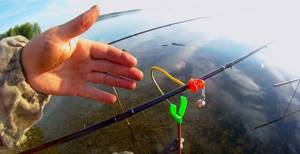
The float is mounted on a fishing line between two locking rings made of silicone. First you need to measure the depth and then set the correct position of the float. The feeder should completely go to the bottom. In this case, the float must remain on the surface.
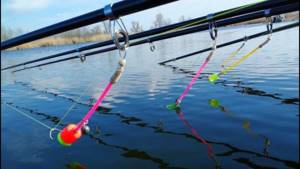
If fishing is carried out on a river with a strong current, such alarms are not recommended. Due to the current, the effectiveness of the alarm will be low.
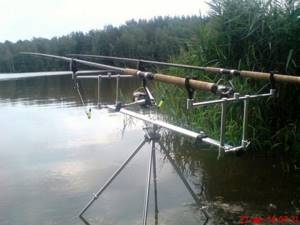
The best electronic bite alarms
Electronic direct alarms react to vibrations of the fishing line and respond with sound and light signals, attracting the attention of the fisherman. Thanks to this functionality, they are easier to notice, even when you are far from the fishing rod. Models with indirect action are equipped with a pager, so the bite signal comes to a device located in the user’s pocket. This is even more convenient and allows you to be away from the rods at the distance specified in the operating instructions.
Prologic K3 Bite Alarm Set 4+1
Rating: 4.9

The set contains four alarms and a pager that receives a bite signal. To alert the fisherman, there are 5 volume levels and a silent mode, in which the LEDs only blink and vibration is triggered. This is convenient if the rest of the team is asleep. The user can adjust the sensitivity of the alarm in four levels. If the line is simply slack, a separate signal with a different tone will sound, so as not to confuse it with a bite. You can also set one of seven sound signals to choose from, so you can choose one that will be clearly audible, but will not frighten you.
The bite indicator set benefits from being completely waterproof. For the sake of 100% waterproofness, the manufacturer even had to abandon the socket for connecting the swinger. The housings of the alarms are not only protected from rain, but also sealed, so an accidental fall into the water, which is not uncommon when fishing, will not harm them.
Advantages
- sufficient supply of threads for fixing to the rack;
- six LEDs on the pager for visual notification;
- convenient case for transportation;
- There is a silent mode and vibration on the receiver.
Flaws
- high price;
- swinger cannot be connected;
- Only for thin feeder rods.
4+1 JZH-RF-1118
Rating: 4.8
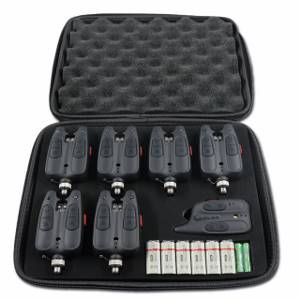
But here is a decent set that costs three times less than the category leader, but has excellent characteristics. The set includes 4 alarms and a pager. If desired, the model supports the connection of two more indicators, with which a 6+1 system is obtained. Everything comes in a durable, foam-lined case for gentle transportation. The user has access to 8 bite volume levels, 8 tones to choose from, and 6 LEDs. When the battery is low, the device triggers an alert. Fishermen in the reviews like that the tone can be set not only in relation to the strength of the bite, but also depending on the direction of unwinding of the cord. All settings are saved in memory and on your next fishing trip you won’t have to fiddle around for a long time before starting.
Alarms are interesting not only for their bite detection functions, but also for their additional capabilities. For example, here you can set the “Anti-theft” mode, in which the device will “scream” if someone tries to remove the rod from the stand in your absence. At the same time, a signal about unauthorized actions will be sent to the pager. This feature is useful in crowded waters if your camp is set up far from the shore.
Advantages
- convenient case with foam lining;
- rubberized buttons for settings;
- individual light indication;
- Possibility to connect two more alarms.
Flaws
- cannot be dropped into water;
- high price.
SWD JHA-521 (4+1)
Rating: 4.7
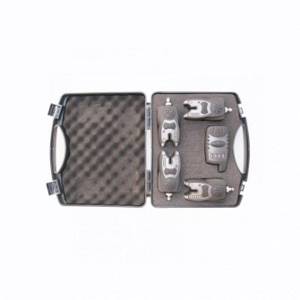
Among the proven 4+1 alarm kits, a popular option is the SWD JHA-521. The bite detection device can be adjusted to 5 sensitivity levels and the direction of unwinding of the fishing line. There are also 5 tones and a silent mode available. The waterproof housing allows you to use the gear in the rain. The pager has an LED indication and five volume levels. The receiver's response range from the emitters is 150 m. If you want to connect a swinger, the manufacturer has provided a 2.5 mm connector. According to reviews, the product has proven itself best when fishing for carp.
We singled out the alarms for their reliable operation of automatic night lighting. When there is a bite, the indicator will illuminate the rod, and this will allow you to grab it securely for hooking.
Advantages
- you can fish in the rain;
- 5 sensitivity levels;
- there is a silent mode;
- range from the receiver is 150 m.
Flaws
- will spoil if dropped into water;
- You cannot connect more than 4 alarms to the pager.
German Barracuda TS 4+1
Rating: 4.7

The set for use on 4 rods is equipped with alarms with a universal thread for stands. The semicircular cutout makes the model convenient for positioning feeders and other gear. Each indicator has four buttons for adjusting volume, tone, sensitivity and backlight. The rubber ring on the thread ensures a strong fixation to the stand - the support will not rotate spontaneously. Reviews show that threading the fishing line into a special slot is not difficult. The set comes with a pager with a range of up to 100 m. It has its own speaker, so when there is a bite, the sound signal will come from both the alarm and the receiver.
The “4+1” set is interesting because the radio has a screen with numbers instead of colored diodes. When the alarm is triggered, its number lights up. This allows you to react faster to understand which rod to grab. Competitive models use color coding and you need to remember which is which. Here, the system with numbers saves decisive fractions of a second so as not to miss the prey.
Advantages
- can be used stationary or with a walkie-talkie;
- communication range with pager up to 100 m;
- durable soft plastic;
- Fishing is allowed in the rain.
Flaws
- The buttons on the alarms are set deep and are inconvenient to press for people with large fingers.
Flajzar Neon TX3 Set 4+1
Rating: 4.6
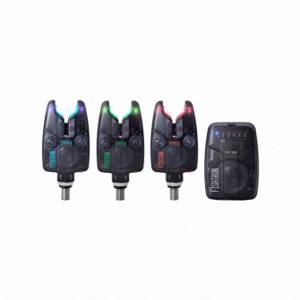
This is a premium set of electronic alarms that allows you to adjust the line sensitivity to fluctuations from 4 mm to 10 cm. While you are installing the rod again after casting, the trigger function can be temporarily disabled by pressing the Mute button. Anglers in the reviews like that this series is protected from moisture penetration inside, so the bite indicator will not deteriorate if it is accidentally dropped into a pond.
The feature of such alarms is a translucent body, inside of which there are several rows of LEDs. When biting, they don’t just blink, but indicate the direction in which the fish is pulling the line. This allows you to determine how to hook the prey even when approaching the rod. The second feature of the alarm is automatic brightness adjustment, depending on the ambient light. On a sunny day, the diodes will flash at maximum so that you notice the glow. In the dead of night, the light bulbs produce subdued light, so as not to create a “disco” on the shore.
Advantages
- “smart” light indication indicating direction;
- sound alarm with the ability to determine the side of the line unwinding;
- waterproof case;
- automatic brightness control.
Flaws
- high price.
Photo of a bite alarm for a feeder
Note!

Catching crucian carp on a feeder - tips and secrets of professionals. 115 photos and videos master class for beginners- Bait for the feeder - popular mistakes, recipes and do-it-yourself bait. Ingredients for bait (110 photos)
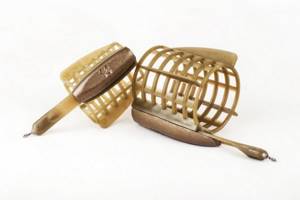
Feeders for feeders: feeder design, equipment and tips for beginners (125 photos and videos)
Read here Roach on the feeder - choice of gear, tips on how to catch and the main features of roach fishing (115 photos)
Help the project, share on social networks 

0

